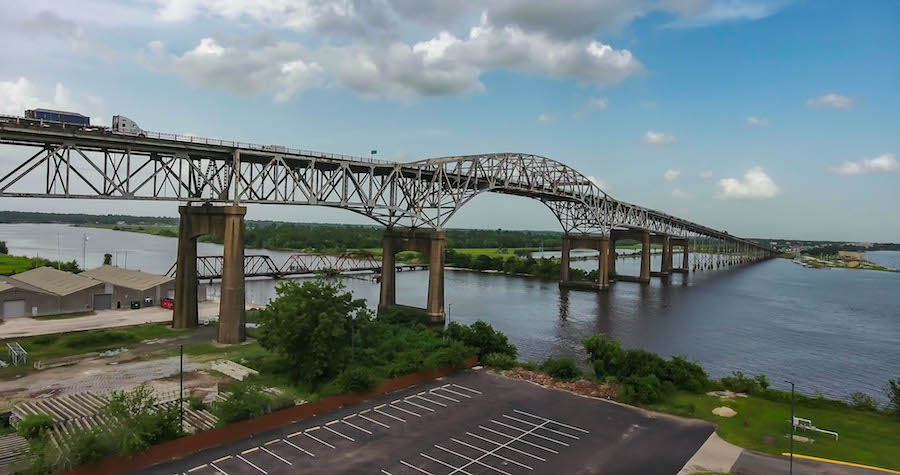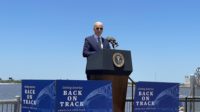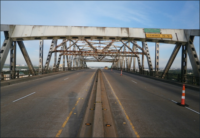Officials Determined To Replace Calcasieu River Bridge

It could take at least four more years for the existing Calcasieu River Bridge to be replaced.
Photo by PJ Hahn
A lot still needs to happen before the state of Louisiana can replace the 70-year-old, dilapidated Calcasieu River Bridge on Interstate 10 in Lake Charles, and one official says it could take until at least 2024 for the project to break ground. But officials believe they are starting 2020 in a better position to move the project forward.
There’s been an overwhelming demand from the public to replace the bridge, which is nearly two decades past its intended life span. But before the project can enter the procurement phase, state officials must find funding to build the estimated $850 million bridge. They must also complete an environmental impact statement in order to qualify for federal money to build the bridge, which is considered functionally obsolete and structurally deficient.
“There is a path. It takes a good bit of work to get there, but it’s fully under way,” says Gen. John Basilica, Gulf Coast office leader for HNTB, the firm writing the environmental impact statement for the state.
Officials were encouraged this year by a pledge from Gov. John Bel Edwards to fund the state’s share of the project. They have also narrowed down their options for building the bridge from five alternatives to two, and are predicting that they could have the environmental impact statement completed by the end of 2020. After holding public hearings, the state could have a final statement ready to submit to the Federal Highway Administration by 2021, says Eric Kalivoda, deputy secretary for the Louisiana Dept. of Transportation and Development.
After the FHA gives the green light on the statement, the state can begin the process of procuring designs and firms to do the work. It would likely take another two to three years to get through design process. “I wouldn’t expect construction to begin until at least 2024 at the earliest,” Kalivoda says.
Funding in Question
Key to moving the project forward is funding, and officials are trying to determine whether the bridge will be able to rely on traditional federal-state funding methods, or if the state should pursue a public-private partnership (P3), under which tolls would pay for the majority of the project.
Three months before being reelected in November, Gov. Edwards pledged $85 million from Louisiana’s 2020 capital outlay bill to fund the state’s share of the project. Under traditional federal-state funding methods for transportation projects, the federal government pays 90% and the state pays 10%.
“The most significant development that has taken place is the fact that Gov. Edwards was reelected. And we presume Dr. (Shawn) Wilson will remain secretary of transportation. So from the standpoint of continuity of leadership, there won’t be a big hiccup. I can’t underscore how important that is,” Basilica says.
Edwards made the pledge a few weeks after President Trump visited Lake Charles and told crowds that if he is reelected in 2020, “we’re giving you a brand new I-10 bridge.”
Trump did not elaborate on how the federal government would pay for the bridge, or to what extent – leaving those comments up for interpretation. Kalivoda points out that Trump has been a leading advocate for public-private partnerships and the use of tolls.
“When he says he’d pay for the bridge, what he might mean is that he’d pay any gap if the tolls can’t cover an entire replacement,” Kalivoda says.
In January, the Southwest Louisiana Chamber’s I-10 Bridge Task Force proposed a plan that would allow for a new bridge to be completed within three years. The task force concluded that the only way to complete the project in a “reasonable” amount of time would be through a P3.
“That may be true, because right now there is not sufficient public money available to construct the project,” Kalivoda says.
A provision in federal law allows for the use of tolls in order to replace an existing interstate structure without any added expense. The state is conducting an analysis to determine whether tolling would cause an undue impact to lower-income individuals.
Ongoing Environmental Study
Basilica says officials are making “good progress” on the environmental impact statement, and that the study is moving “full speed ahead.”
In preparing the statement, officials must take into account a range of variables, including cultural resources, environmental justice issues regarding how tolling might affect the population, exit ramp designs, drainage, navigation issues associated with building on the Calcasieu River, and the bridge’s complex footprint in an industrial area.
“Nothing about it is really simple. So we have to take it one step at a time and do a careful, thoughtful, comprehensive job on the study,” Basilica says.
Officials have narrowed down building alternatives for the bridge from five to two, with the primary difference between them being how to structure the Samson Street interchange on the west side of the bridge in the city of Westlake. A ramp connects Samson Street to I-10, and the community has raised concerns that there are active rail lines that often block access to the interstate at the intersection.
The first alternative option would involve leaving Samson Street as is but building an alternate route to I-10 that motorists could use when rail lines are blocked. The second option would be to completely rebuild Samson Street and create an interstate overpass, although that would involve closing Samson Street for over two years. “We have presented that to the public because it’s a lot of inconvenience during the construction period, but we didn’t get a lot of pushback,” Kalivoda says. “They appear to be willing to accept the inconvenience in order to have Samson Street connect over the two rail lines and connect with I-10, rather than having to use an alternate route.”
Further complicating the process of preparing the environmental impact statement is the remnants of an industrial hazardous materials spill on the west approach to the bridge in 1994. Cleanup efforts are still ongoing after 25 years, and there have been concerns about whether pile driving could create a pathway for hazardous materials to work their way into the drinking water aquifer.
“That’s caused us quite a bit of concern and delay on how to reach a decision on how to overcome that,” Kalivoda says.
On Borrowed Time
The Calcasieu River Bridge predates the U.S. interstate system and opened in 1952 as part of U.S. Highway 90. When Interstate 10 was constructed, it incorporated the bridge and other existing infrastructure from U.S. 90 as a cost-saving measure.
The bridge was designed for a traffic load of 37,000 vehicles per day. In 2016, the average daily crossings were more than 80,000, according to the Southwest Louisiana Chamber.
The American Road & Transportation Builders Association has classified the bridge as structurally deficient and functionally obsolete, and the National Bridge Registry has assigned the bridge a 6.6 rating out of 100. By comparison, the Interstate 35 West Mississippi River Bridge in Minneapolis had a rating of 50 when it collapsed in 2007, according to the I-10 Bridge Task Force.
There are no shoulders on the four-lane bridge, and it has a 135-ft clearance over the Calcasieu River. It’s also nearly two decades past its 50-year life span.
“It’s steep, and it’s narrow. It also vibrates quite a bit,” Kalivoda says, adding that the state has not been able to maintain a lighting system on the bridge because there is too much rattling to keep any lights in place.
Officials want the new bridge to include six lanes with shoulders, and they want to lower the bridge height to 73 ft., which is the standard for shallow-draft waterways in Louisiana. The bridge would also have a 3% grade instead of a 5% grade. “So it wouldn’t be nearly as steep, and certainly it will be much wider than the current bridge,” Kalivoda says.





